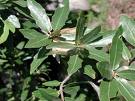Blackjack Oak Tree Information
Images of Blackjack Oak:






Blackjack Oak grows in the following 5 states and provinces:
Arizona, Colorado, Maine, New Mexico, TexasInformation about Blackjack Oak:
The Quercus Emoryi is commonly known as the Bellota, Blackjack Oak as well as Emory Oak.
The currently accepted scientific name of Emory oak is Quercus emoryi Torr. It is a member of the oak family (Fagaceae) . No infrataxa are recognized. Where distributions overlap in Texas, Emory oak hybrizes with graceful oak (Q. graciliformis) to form Tharp oak (Q. xtharpii C. H. Mull.) and Graves oak (Q. gravesii) to form robust oak (Q. xrobusta C. H. Mull.) .The range of Emory oak extends from central Arizona eastward through southern New Mexico into western Texas . Its range continues southward through northern Mexico from Chihuahua west to Sonora and south to Durango .Emory oak occurs in many communities along diverse elevational and moisture gradients from pine-oak (Pinus spp.-Quercus spp.), Madrean evergreen, and open oak woodlands to interior chaparral, semidesert grasslands, and savannas . Emory oak is a codominant or subdominant species in all community types of the pine-oak woodlands of higher elevations . It is an indicator species in ponderosa pine (Pinus ponderosa), Apache pine (P. engelmannii), and Chihuahua pine (P. leiophylla var. chihuahuana) habitat types and border pinyon (P. discolor) community types . In pinyon-juniper (Pinus spp.-Juniperus spp.) woodlands, Emory oak is a codominant or an indicator species . It is an important understory species in pinyon-juniper stands . Emory oak is dominant or codominant with Arizona white oak (Q. arizonica), Mexican blue oak (Q. oblongifolia), and juniper in Madrean evergreen and open oak woodland series . Emory oak is the most characteristic tree of encinal or oak woodlands in the border region of Mexico and the United States . In the Chihuahuan Desert, Emory oak is codominant with gray oak (Q. grisea), Graves oak, and Mexican pinyon (Pinus cembroides) . Emory oak is occasionally present in the interior chaparral as a subdominant shrub or as one of the taller evergreen oaks. These interior chaparral communities occur discontinuously and extend into the wetter Madrean evergreen woodland . Emory oak, gray oak, and Chisos oak (Q. chisoensis) form savannas at the periphery of grama (Bouteloua spp.)-bluestem (Andropogon spp.) associations . Emory oak is a minor species in open savannas of velvet mesquite (Prosopis velutina)-turpentine bush (Ericameria laricifolia)-burroweed (Isocoma tenuisecta) associations . Emory oak is known as an upland species but also occurs in riparian associations. It is a codominant to infrequent tree in Arizona sycamore (Platanus wrightii) and Arizona walnut (Juglans major) community types . Emory oak occurs in mixed broadleaf community and vegetation types with Arizona cypress (Cupressus arizonica) . Some of the publications in which Emory oak is listed as a dominant or indicator species are: (1) Classification of the forest vegetation on the National Forests of Arizona and New Mexico (2) Forest and woodland habitat types (plant associations) of Arizona south of the Mogollon Rim and southwestern New Mexico (3) Forest habitat types south of the Mogollon Rim, Arizona and New Mexico (4) Classification of mixed broadleaf riparian forest in Tonto National Forest (5) A forest habitat type classfication of southern Arizona and its relationship to forests of the Sierra Madre Occidental of Mexico (6) Plant communities of Texas (Series level): February 1992 . Succulent species associated with Emory oak but not previously mentioned in Distribution and Occurrence include Echinocereus ledingii, Mammillaria viridiflora, and Opuntia spinosior .Some of the information provided here is attributed to:Pavek, Diane S. 1994. Quercus emoryi. In: Fire Effects Information System, [Online]. U.S. Department of Agriculture, Forest Service, Rocky Mountain Research Station, Fire Sciences Laboratory (Producer). , available at the USDA Fire Effects Information System (FEIS) website